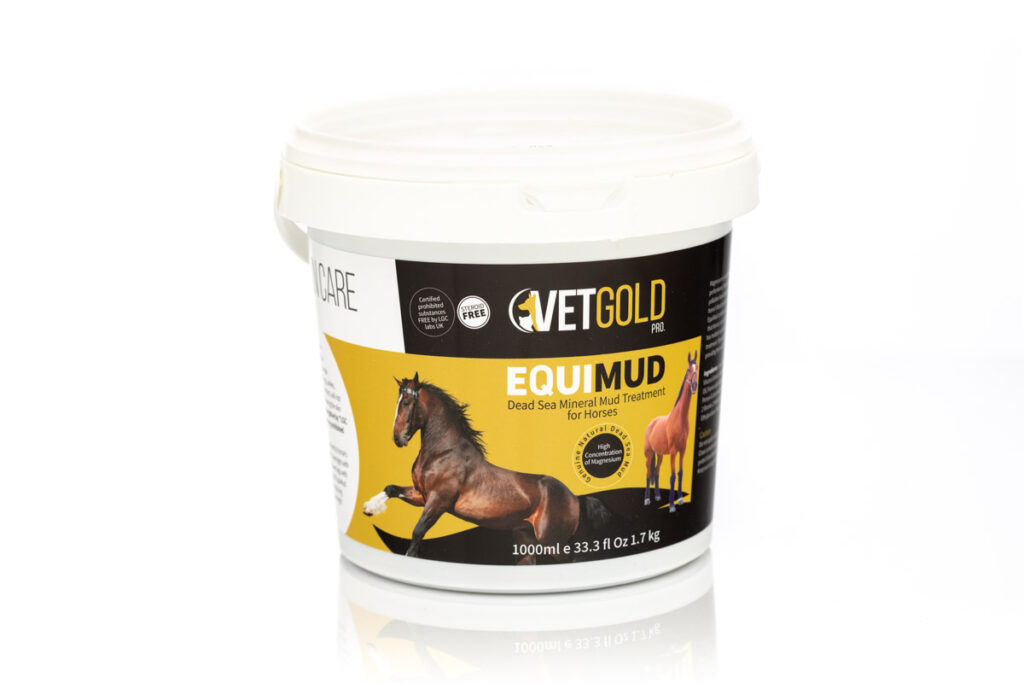Field Trial in England from 20.09.18 until 04.10.18
conducted by Elizabeth Newman, Equine Consultant.
Purpose of the trial
To test VetGold EquiMud and VetGold Cream on various equine conditions so as to
ascertain their feasibility as suitable products for the equine industry.
Prior to commencement of the trial, samples of both products were sent to LGC
Laboratories in Newmarket, England to obtain certification that they were free of any
substances prohibited by both the HRA and FEI.
Subject horses
The horses selected for the trial were a mixture of breeds, ages and disciplines such as
racing, show jumping, dressage, hunting and general riding. The horses were based at
Lower Haddon Livery and Kennel Field Stables.
Reaction of trial participants to using the products
VetGold Cream was considered simple to apply and achieved results quickly. Negative
comments were that the tube is too small for horses and that, if left in the tack room
overnight, it became very solid and needed to be warmed up before use.
The temperature in the UK overnight during the trial was between 5c and 11c.
(tube needs to be kept at room temperature).
VetGold EquiMud was very popular and succeeded in treating lots of conditions. It was
also, very good for routine treatment after a workout or competition as a preventative
measure. Other positive comments were that it was easy to apply and wash off – some said that it brushed off easily after overnight treatment on Thoroughbred horses (they have fine
coats).
Trial participants at Lower Haddon Livery
DOM
5 years old Cob gelding
hunting and general riding
owned by S. Kempster
Dom bites his lower forelegs to ease the itching caused by mites. We coated the area
with EquiMud for 3 nights and washed it off in the morning. No wraps were applied.
After ceasing treatment with the mud, we applied Vet Gold cream for 7 days. Itching /
biting ceased and has not resumed.
MAC
7 years old Arab x Welsh gelding
show jumping and hunting
owned by E. Caunter
Mac’s legs fill overnight regardless of whether he has worked or not. We applied
EquiMud as for routine application use, legs coated in mud between bottom of fetlock
joint up to just below the knee, wrapped legs in wet brown paper to cover mud, applied
leg wraps and stable bandages. We left on overnight and washed off the following
morning. Mac’s legs were cool and no swelling was felt the following morning. The
owner was particularly impressed by how easily the mud washed off without
discoloring Mac’s legs. Mac is a light grey, almost white, horse and his owner has tried
various clay products in the past that have stained his legs.
HARRY
7 year old Irish Draught gelding
competing at top level Working Hunter competitions
owned by E. Morrell.
Harry suffers from tightness through both shoulders which we treated with EquiMud.
We applied a 1 cm layer of mud to his shoulders and neck, covered with a warm damp
towel and neck stocking. We washed the mud off after 4 hours. His owner said he felt
much more supple, when she rode him after treatment.
ABELARD
24 years old Warmblood gelding
dressage and hacking
owned by N. Tilton
Abelard had 2 problems, Windgalls on a hind leg and restricted movement through his
fore fetlocks due to tight skin (presumably due to a previous bout of mud fever). The
Windgalls are no longer visible but they certainly restricted elasticity of movement
during trot, particularly for a dressage horse. We applied the EquiMud to his hind leg using
the routine application method and we applied VetGold cream to his fore fetlocks. We
did with for 8 nights. Following treatment there was a tremendous improvement in
movement. Abelard is an older horse and the owner was overjoyed with the results.
CHELSEA
23 years old Irish Cob mare
hacking, 1 day eventing
owned by A. Wilkinson
Chelsea suffers from scurf, particularly behind her knees. We applied Vet Gold cream to
the area for 10 days and the improvement was very good. I suggested that VetGold
cream should become part of Chelsea’s daily grooming routine to generally improve the
dry scurfy areas.
MADDY
Maddy is a 20 years old Clydesdale mare
dressage, hacking
owned by M. Thomas
She suffers from Sweet Itch to her pasterns and part of her fetlocks. We applied the
VetGold Cream for 9 days and the irritation ceased. The owner was very happy
because she had tried many other products previously that had failed to relieve Maddy’s
stamping and therefore the itching. (My opinion is that Maddy’s condition is not classic
Sweet Itch but a type of fungal infection – either way the VetGold solved the problem).
LIV
Liv is a 16 years old Dutch Warmblood gelding
Grand Prix dressage
owned by B. Tilton.
Liv suffers from filled and sensitive legs after work. We applied the EquiMud using the
routine application method with bandages etc. overnight. The legs were cool and
unfilled in the morning. The owner was very pleased with the results and also
impressed at the ease of removal compared to Ice Tight.
AMMO
Ammo is a 10 years old German Warmblood gelding
Dressage
owned by B. Tilton.
Ammo has a hoof problem that started with his previous owner and that was so severe
removal of some of the infected tissue had to be carried out by the vets under
anesthetic. Although the vets removed some of the infected tissue during his surgery a
year ago, some still remains. The clefs of the hooves felt slimy and jelly-like and the
smell was overpowering, similar to Thrush but far more pungent. The owner has tried
many treatments from her vet and farrier but nothing has worked.
I was unsure whether the EquiMud or the VetGold was the best solution so we treated
the front hooves with EquiMud and the back hooves with VetGold Cream, tubbing then
applying the products and padding and wrapping as for a hoof poultice. We did this for
4 days each night and washing off in the morning. After this period, it was apparent that
the EquiMud was doing a marginally better job (although the VetGold Cream had also
improved the condition).
We then applied EquiMud to all four hooves in the same way for a further 10 days.
Ammo has improved dramatically. The smell no longer exists, the frog and clefs are
smooth and free of jelly. Ammo was very sensitive to touch in the clef / frog and rather
‘footie’ on uneven ground. He is now walking normally and sensitivity is minimal. This
problem is a deep infection over many years that has not previously been fully resolved.
I have advised the owner to continue tubbing and applying the EquiMud each night until her
farriers next visit. He will then trim and remove dead horn from the hooves and
hopefully enable the mud to access deeper into the hooves. I suggested they resume
the same treatment for 10 days after the farrier visits and then we will review.
INDI
21 years old Connemara x Welsh x TB mare
showing, hacking
owned by J. Hayes.
Indi suffers from severe Sweet Itch to her mane and wither area. Her owner has tried many
products but nothing has solved the problem. We applied VetGold cream morning and
evening for 10 days. The itching ceased after 2 days and she no longer rubbed the
area. By day 10 there had been a tremendous amount of hair re-growth over the
affected area. The owner was very impressed. SEE PHOTOS INDI
(We used 3 tubes over 10 days)
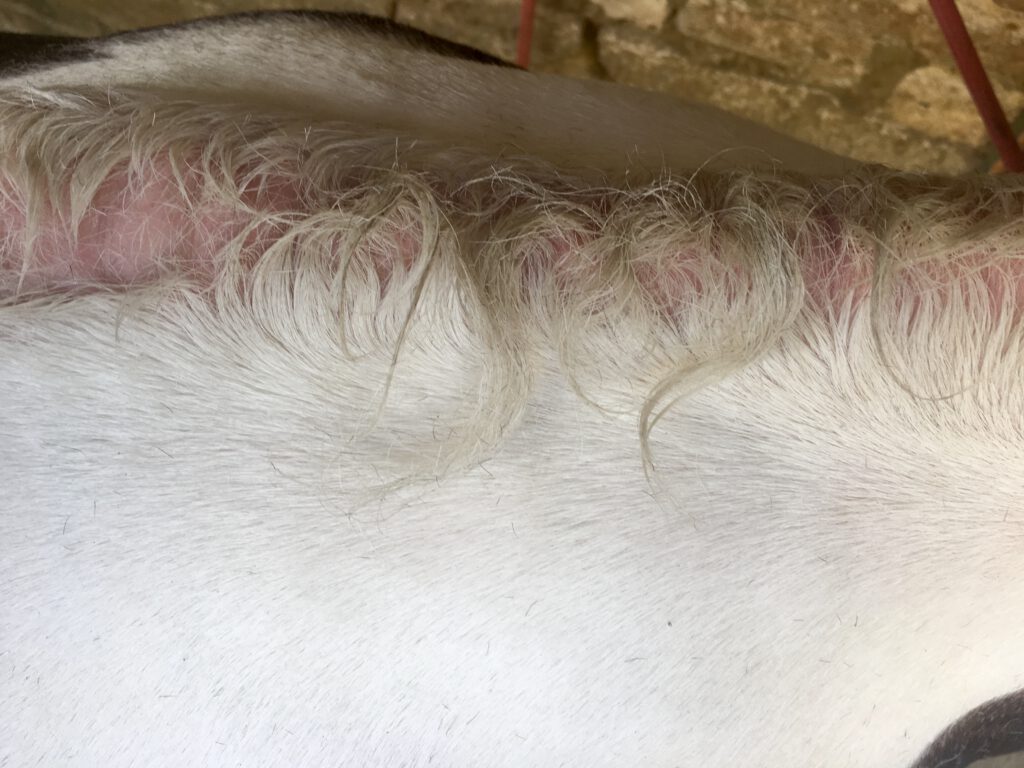
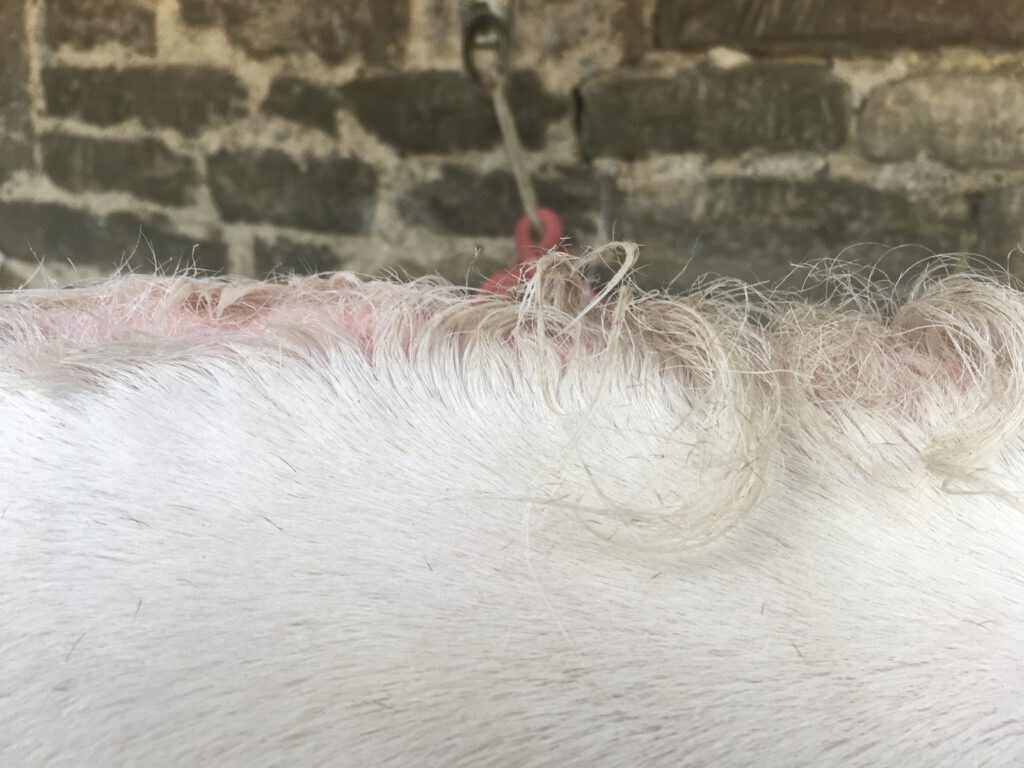
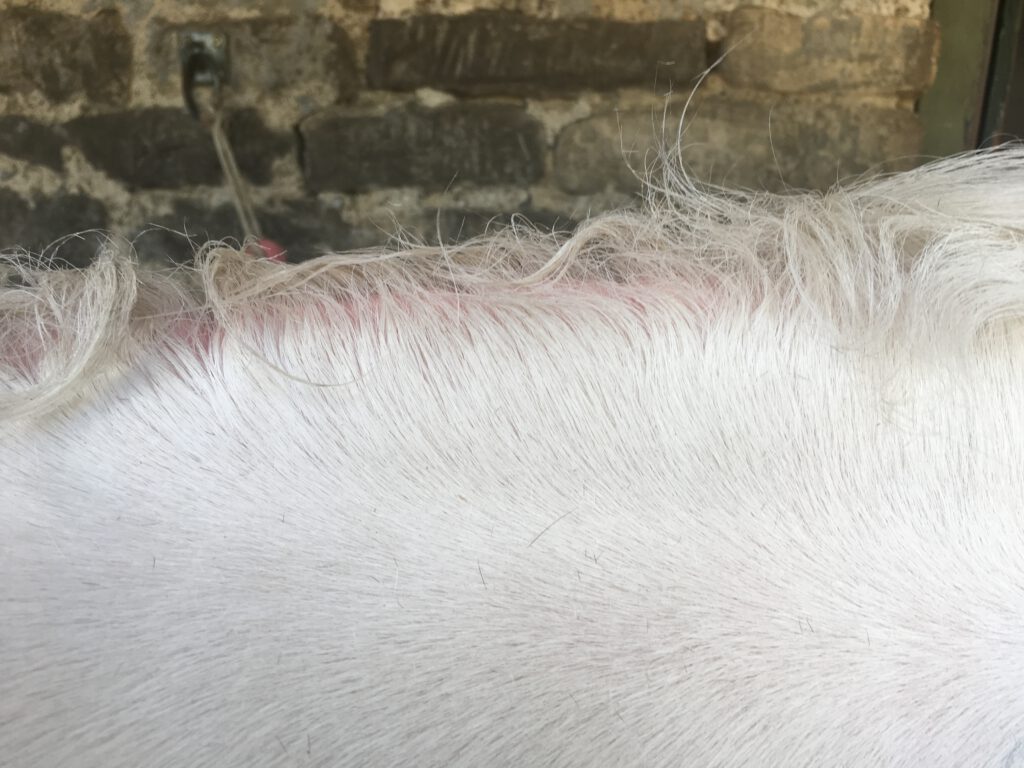
GUCCI
9 year old Irish Draught gelding, top level showing, owned by E. Morrell
Gucci has an undefined skin condition that flares up periodically regardless of the
season. Several vets have been unable to diagnose the problem which creates ugly
areas of skin. It self-heals, usually within 2 weeks which is a disaster for a top level
show horse who is judged in competition on his turnout and coat quality. We applied
EquiMud to the affected area in the evening, we did not apply a dressing. We washed it
off in the morning and applied VetGold cream after towel drying the area. We repeated
the routine the following day. Within 48 hours the affected area was healed completely.
SEE PHOTOS GUCCI
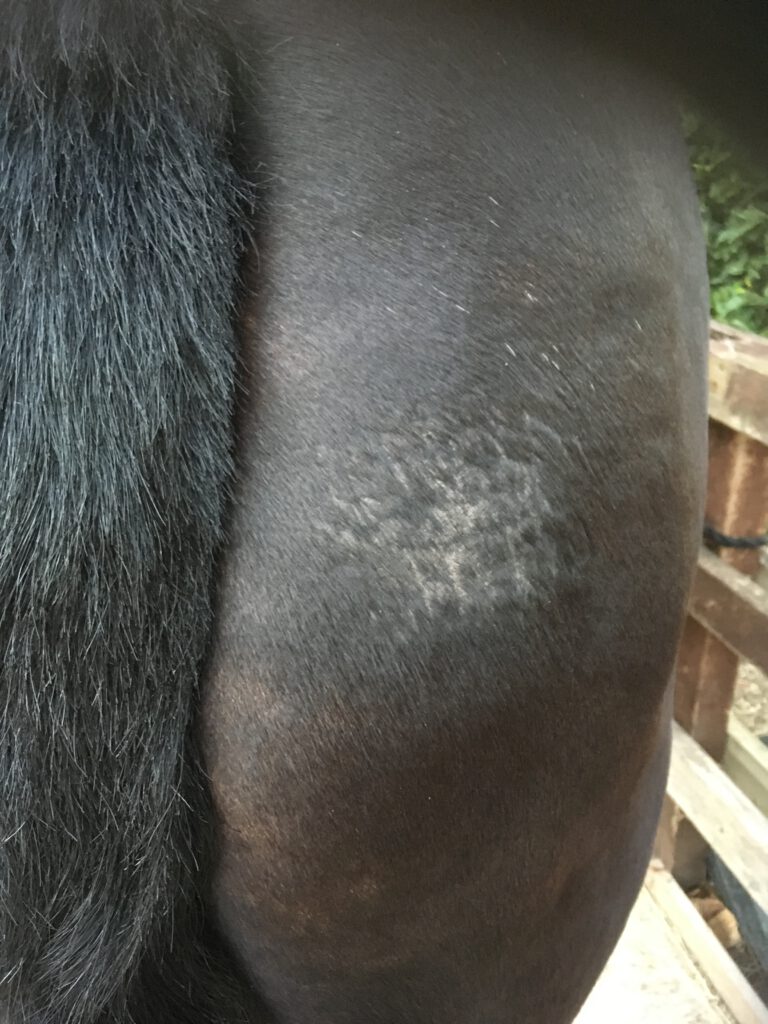
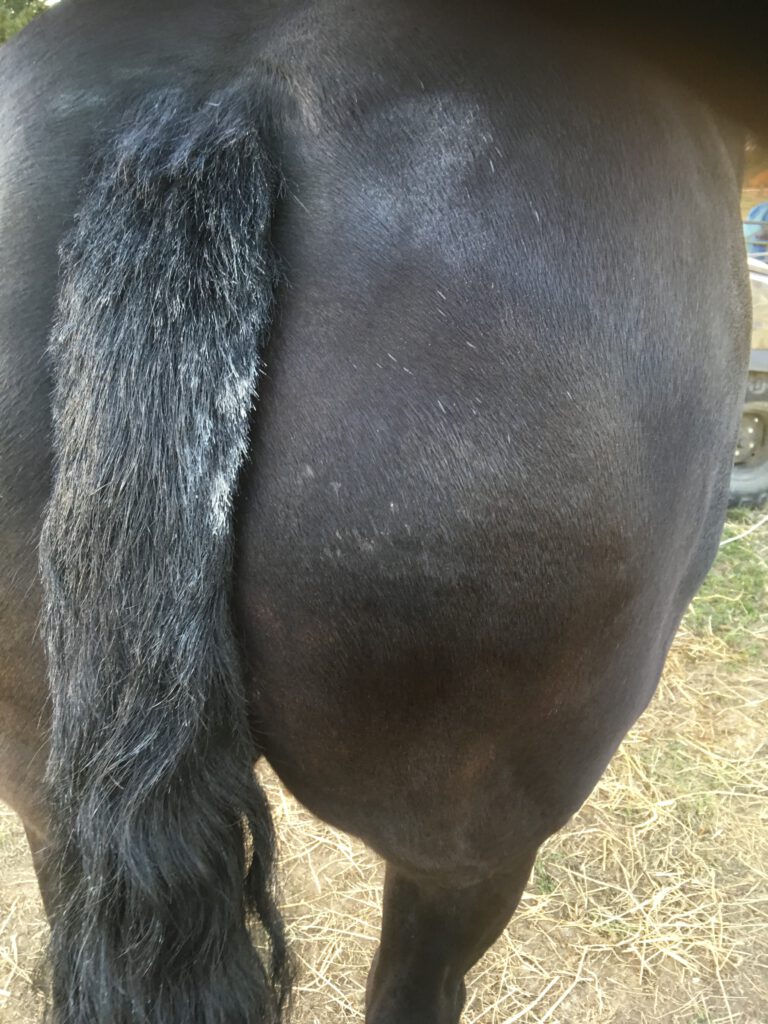
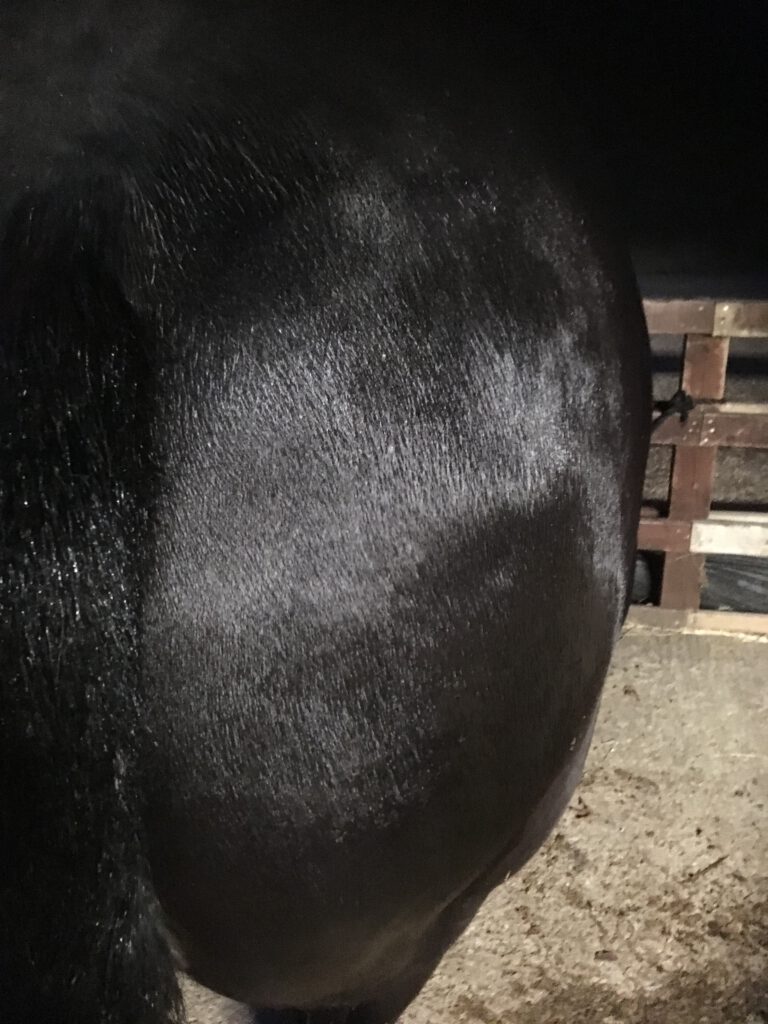
KIA
25 years old Welsh Cob mare
dressage, hacking owned by H. Pegram.
Kia suffers from severe Mud Fever in the winter. In the summer months it subsides but the skin around her fetlocks and pasterns feels grainy and lacking in elasticity which affects her movement. This is a common feature of Mud Fever in remission. We applied VetGold cream twice a day for 7 days. The texture of the skin improved noticeably during this time. (I explained to the owner that when the Mud Fever returns in the winter – as I am sure it will -she should treat nightly with EquiMud.
Trial participants at Kennel Field Stables
RUBY
15 years old miniature Shetland mare
Companion
owned by C. Stephen.
Ruby was suffering from Sweet Itch to her mane causing itching and rubbing although
she had not yet managed to rub out much or any of her prolific mane when we
commenced treatment. We applied Vet Gold cream twice a day and Ruby stopped
rubbing after day 3.
ROSE
11 years old Irish Cob mare
Hunting
owned by C. Stephen.
Rose suffers from Mite infestation to her lower legs causing her to stamp her feet to relieve the itching this causes. This is a common problem with her breed. Unfortunately
the stamping creates a lot of foot and leg problems for the horse over time. There is no
effective cure except in some cases vets recommend IV Ivermectin. This drug is not suitable and potentially dangerous for a lot of horses. We applied a 1 cm layer of EquiMud over the entire lower legs from just below the knee to above the coronet band. In this yard all the horses are stabled at night and turned out in the field during the day. We applied the mud in the morning and turned her out without wraps or bandages. When we brought her in in the evening we washed off the mud, towel dried and re-applied, again without wraps. After 3 days the stamping had stopped. We continued to follow the treatment plan for a further 6 days. Since I left Rose has not started stamping again.
KEVIN
22 years old Irish Cob gelding
Show jumper owned by C. Stephen.
Kevin is from the same stable as Rose and the same breed. He was also suffering from Mites. We treated him in the same way as Rose and the results were identical.
PEGGY SUE
9 year old Irish Cob, mare carriage driving owned by C. Stephen.
Peggy Sue is from the same stable as Rose and Kevin and is also the same breed. She also suffers from Mites. Again, same treatment routine, same excellent results.
Trial participants at Keeper’s Stables
Keeper’s is a racing stable so all the participants here are racehorses. They all race on the flat and there were 30 horses in training during the trial. During the trial period when I was in the UK I visited daily. We decided to select 5 subject horses who are regularly bandaged at night and to apply the EquiMud using the routine application method. There was a noticeable difference in the horse’s legs the following morning,
particularly following fast gallop work or racing.
During the trial none of the horses had cuts or skin problems which warranted using the VetGold cream. However, at the end of the trial, I agreed with the trainer that he would continue with the routine treatment on the subject horses. Also, I left him some VetGold cream to try if any injuries occurred.
We decided to extend the trial for a further 6 weeks after I left during which time we have been discussing cases as they arise. At the end of the 6 weeks period I will obtain a testimonial from the trainer giving his view of the products and will update the subject horses with any changes and add new horses. During the extended trial the trainer may include any of his 30 horses depending on their circumstances.
5 horses that we applied EquiMud using the routine application method (referred to by their stable number 7,12,13,17,28)
These 5 horses were used to having their legs hosed for 5 – 10 minutes with cold water after work and then wrapped with pads and bandaged. We applied EquiMud using the routine application method during the 14 days period.
The results were far better when we used the EquiMud. The legs felt much tighter and there was no swelling.
SUMMARY
The trial was very successful and demonstrated that the products were good for many different conditions affecting horses. The trial included a wide cross section of horse owners and trainers who were all impressed with results.
